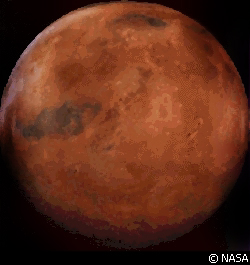Mars facts
Fourth planet from the sun
Last of the rocky inner planets
Roughly half Earths size, 5,794 km in diameter compared to 12,756 km
Year is roughly twice as
long: 687 days
Comparable
day: 24 hours, 40 minutes
Two
moons: Deimos and Phobos
Surface temperature of -35 to -75 C
Very thin
atmosphere, about 100 times less dense than Earth's, so any water would boil away instantly
Mostly carbon dioxide
|
Visions of water flowing on the surface of Mars have long been confined to the realm of science fiction, but a new study of the Red Planet is showing they may be closer to science fact than previously thought.
NASA’s Mars Odyssey spacecraft began orbiting Mars almost five months ago. At the beginning of March, the probe sent back preliminary information showing a high concentration of hydrogen in the south pole, indicating a possible source of frozen water.
Scientists are hoping to confirm there is water ice on or under the surface, for if water once ran there, it increases the possibility that microbial Martian life may have evolved in the distant past.
"The essential condition for life to appear is liquid water," says Isabelle Tremblay, a systems engineer with the Canadian Space Agency.
The search for water is being performed with the gamma ray spectrometer, a sophisticated piece of electronic equipment on Odyssey capable of analyzing the atomic signatures of elements in the Martian soil.
 |
| Mars has long fascinated people. NASA is currently searching for frozen water. |
All elements, including hydrogen, emit unique gamma rays when they are exposed to solar radiation. Essentially, gamma rays are cosmic fingerprints, and the GRS is a sophisticated magnifying glass. It will look at 20 elements, including:
silicon
oxygen
iron
carbon
magnesium
potassium
aluminum
calcium
sulfur
hydrogen
Hydrogen is the most important, since it is the main element in water.
NASA describes the GRS as a "virtual shovel" because it can detect radiation down to approximately one metre below the surface, the place where most scientists expect to find frozen water.
"To verify that water exists we need to go below the surface," says Tremblay. "Deep drilling equipment [will be necessary] to dig deeper and find further traces of water in the Martian soil."
While Mars is now too cold for anything to survive, some scientists believe ancient Mars (about 3.5 million years ago) had a thick atmosphere of carbon dioxide and was warm and wet enough to have supported life. The large hydrogen reading coming from the south pole which Odyssey is detecting lends credence to that theory.
How GRS works
When atoms are hit with cosmic rays, neutrons are released. These neutrons then collide with each other, causing the atoms to "get excited." In order to come down to their normal, calm state, atoms emit energy in the form of gamma rays, much like excited children are sent outside to run off their excess energy. The GRS can analyze the gamma rays to determine how abundant various elements are and how they are distributed on Mars' surface.
History of the search for water
Scientists in the 1800s and early 1900s believed water still flowed on the Martian surface, due mostly to the poor quality of their telescopes. The most famous of these is Giovanni Schiaparelli, who described the canali of Mars. The Italian word for channel was mistranslated into "canal" in English, leading some to believe an intelligent Martian civilization had evolved. This was disproved in the 1970s, when the Viking landers brought back photos showing an arid, barren Martian surface. However, those same pictures also showed valleys, channels and craters that scientists believe were caused by ancient flowing water.
|
The GRS is under the control of Dr. William Boynton of the University of Arizona. When the first results were sent back from Odyssey, he said that they sent a "whopping large signal" that there is a great deal of hydrogen in Mars' south pole. Previously, scientists were unsure if the polar caps were made up of water ice or frozen carbon dioxide.
Beyond simple scientific curiosity, scientists have a more practical reason for hoping to find water: any future manned missions to Mars would be made far simpler and cheaper if there was a source of drinkable water already on the planet.
"In the long term the world's space agencies want to send people to Mars," says Tremblay. "The objective is to gather all the information necessary to let humans survive on Mars."
Water is heavy and hard to transport, so if a shuttle crew could distill water once it reached Mars, the spacecraft would be much lighter, thus requiring less fuel and being less expensive to send out. The crew would then only have to bring enough water to reach Mars; exploration and the return journey could be provisioned from the planet itself.
|

